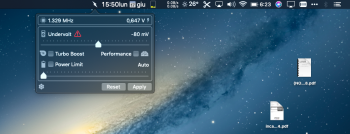The Sabrent's NVMe current draw is _higher_ than Apple's AHCI power draw. That's why the battery life will be shorter with the Sabrent.
The numbers came from sensors provided by iStat Menus 6.31;
@gilles_polysoft published his "NVMe consumption test procedure" earlier in the thread and I used that to get these numbers. The software lets you drag icons to your Menu Bar to display sensor readings as you run various tests or as the machine is sitting idle. I used the following setup:
View attachment 843225
Which for the Sabrent yielded numbers such as:
View attachment 843226
The menubar current sensor only shows one digit past the decimal point. If instead you use iStat's pull-down menu & sensor graph (as shown in the test procedure), you get two digits past the decimal point. I used that to get the Apple SM0512G AHCI idle current because the Menu Bar showed 0.0A; 0.04A was the typical value shown on the graph.
I previously got lazy ("Must be my Hogwallop blood.") and pulled the Sabrent idle current from the MenuBar, then made a worst-case correction for rounding error. Doing it right this time, I just checked the Sabrent number on the graph and it showed 0.20-0.21A at idle. So a more accurate calculation would be:
<<< Given values preceded by &ersand, measured values preceded by •bullet, (Calculations in parenthesis)>>>
& System voltage powering the SSD: 3.3V
• Apple SM0512G AHCI idle current: 0.04A
• Sabrent SB-ROCKET-2TB NVMe idle current: 0.21A
(Increased current draw with the Sabrent SSD = 0.21A - 0.04A = 0.17A)
(Increased power consumption with the Sabrent SSD = 0.17A x 3.3V = 0.56W)
• System idle power usage with Sabrent: 11.5W
(System idle power usage with Apple AHCI = 11.5W - 0.56W = 10.94W)
(% additional power usage with the Sabrent = ((11.5W/10.94W) - 1) x 100 = 5.12%)
So the Sabrent 2TB NVMe uses just over 5% more current/power than the Apple 512GB AHCI drive at idle. The Sabrent may use more than +5% under load, but about 80% of typical use is at idle (especially on battery); I believe this is a reasonable number to use for increased draw while on battery.
As to how the increased current draw affects battery runtime, drawing +5% current from a battery will have at least a -5% affect on runtime. We're talking about low current rates, so it won't be too impactful. Probably, the effect will be a 5.5-7.5% decrease in runtime.
(also note that the above system power of 9.5W is lower than the 11.5W used in the run time estimate. 9.5W was only achieved with screen backlighting almost completely off and with keyboard backlighting off. 11.5W was typical during daytime indoor illumination usage.)
@Earl Urley has made the first post in this thread a WikiPost to accomplish exactly what you are recommending. If he and all the others hadn't been compiling and organizing this information, I wouldn't have attempted it. My thanks to Earl,
@gilles_polysoft, and all the others who have brought us this far. Please contact Earl to see what you can do to add to the combined body of knowledge.
[doublepost=1560712349][/doublepost]
The exposed pins on your adapter may short to the metal connector housing and cause problems. It looks like there is some tape already on your connector but that it doesn't completely cover the exposed pins. Just to be sure, I'd recommend additional kapton tape. This is an example of one that works without issues:
View attachment 843233
[doublepost=1560713227][/doublepost]
Please forgive me if my previous post was confusing; the thermal pad has _nothing_ to do with your situation. It is a separate item to address a completely different issue.
I believe your issues can be resolved by one or more of the following:
1. carefully inspecting and reseating your drive/adapter/system connector combination,
2. making sure the electrical traces on the adapter are properly insulated to avoid shorting them on the metal connector housing. Given the "2-lane" PCIe setting, this may be your winner.
3. reinstalling the O.S. or reinitializing PRAM as recommended by others herein,
4. using the _exact_ make and model of NVMe adapter proven successful by others herein.





